Unreal II Updated Preview
We visit the Legend Entertainment offices to get a hands-on look at one of this year's most promising action games.
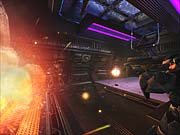
From its inception in 1989, PC game developer and publisher Legend Entertainment focused on one goal: to create compelling, well-crafted adventure games that could be enjoyed equally by veteran adventurers and gaming newcomers. And that's precisely what the Virginia-based company did for the next seven years, with nearly every one of its titles garnering accolades and industry awards. As the decade began to draw to a close, though, the overwhelming popularity of first-person shooters and real-time strategy affairs put a massive dent in sales of adventure games, and it soon became obvious to the top brass at Legend that the sense of pride and gratification of developing and publishing critically acclaimed adventures would not pay the bills.
But while the market for adventure games may have been declining, the ability to tell a good story never goes out of style. After being acquired by GT Interactive in 1998, Legend was tagged by Epic MegaGames as developer for 1999's Unreal Mission Pack: Return to Na Pali. Epic and GT Interactive were so pleased with the result--and with the job Legend had done in developing the award-winning shooter-adventure Wheel of Time--that the erstwhile adventure-game company was handed the prestigious assignment of creating the sequel to Unreal, Epic's flagship title and one of the most popular first-person shooters of all time. Epic is providing the game engine, but as you'll see, Legend is doing quite a bit more than simply adding a story to a shooter.
Infogrames (which acquired GT Interactive in 1999) has been rather stingy in releasing details about Unreal II, but during a recent visit to Legend's studios in Chantilly, Virginia, we were given the opportunity to get up close and personal with the game and gain some insight into what Infogrames, Epic, and Legend are striving to achieve (besides phenomenal sales, of course!) with this hotly anticipated title.
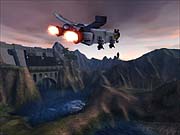
By now, most of you are familiar with the game's plot. Set in the same universe as the original title, the game casts you as a Terran Colonial Authority frontier marshal in the 24th century aboard a decommissioned military patrol ship manned by three misfits (and a weird alien pet called a seagoat). While you ostensibly have authority to enforce the law and protect colonists and civilians in the sector where you've been assigned, the real power lies in the hands of the corporations setting up shop in this new region of space and in the powerful Terran military forces. Your position is tenuous, but luckily things are relatively quiet--until you receive a distress call and soon discover that the sector is now ablaze with battles between mercenaries, aliens, and the Terran military, all searching for seven mysterious artifacts. Over the course of the game's 13 missions (there are 35 levels in all), you'll not only protect innocents caught up in the conflict, but also gradually learn why so many different groups seek to gain control of the artifacts.
Most of the time between those missions will be spent aboard your ship, the Atlantis, where you can roam freely and engage in conversations with your crew and receive mission briefings complete with holographic maps. It's a design similar to the one used by Raven Software for Activision's Star Trek: Voyager Elite Force, but Legend studio head Mike Verdu says the company is intent on taking this sort of character interaction to new heights.
Creating GOLEMs
For Verdu and the Unreal II team, the shipboard sequences are an integral part of the first-person gaming experience, but they're also keenly aware that some shooter fans couldn't care less about chatting it up with First Officer Aida Shen (although the fact that her uniform looks as though it's been sprayed onto her extremely voluptuous body might make some more eager for conversation). To accommodate different players' tastes, the dialogue system has been designed in such a way that those eager for battle can get all the essentials they need to succeed on the next outing in very short order, while those looking for more character development and finer details of the game's back story will enjoy the ability to engage in more extended conversations with the crew.
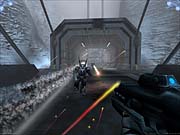
The reason for such a design, says Verdu, is that "we want the dialogue to be a reward unto itself. We don't want to punish the actions of certain players by giving them 'player paranoia,' where they end up wondering if they've been shortchanged for not following a certain path while interacting with the crew. On the other hand, talking with all the crew members can reveal useful information about enemies that can prove helpful later in the game, and it also gives details of the story that will help you piece together the plot as you progress deeper in the game." That's assuming, of course, that you're civil in your dealings with the crew of the Atlantis. Give an abrupt or cynical response to one of them or walk away while they're still talking, and they won't be quite as friendly the next time you meet them; do that repeatedly, and they'll soon give you only cursory replies--and not in a very respectful manner, either.
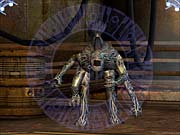
But what's most likely to tempt gamers into interaction with nonplayer characters (NPCs) is GOLEM, Legend's skeletal rendering and animation system, which results in some of the most lifelike behavior and movement ever seen in AI-controlled characters. Developed as a custom solution to speed up the animation process, GOLEM lets programmers "stack" a myriad of animation effects for various meshes (which make up characters) on top of one another. Instead of the predefined animation loops you often see NPCs perform in other games, the interaction of the stacked effects can result in movements you might not ever see a particular character perform again no matter how long you play. The GOLEM system allows for precise lip-synching without canned animations, as well as simultaneous head-eye tracking by NPCs as you walk around them.
What this also does, says Chris Hargrove, senior programmer, is allow artists to do procedural animations rather than being forced to create static animations for every conceivable situation and action. A simple way to think of it is that the artists determine each character's reaction to various "satellites," or objects and characters in the gameworld, while the level designers are responsible for placing those satellites in the gameworld. This approach not only cuts development time--a key reason for the development of GOLEM--but also puts the appearance and behavior of characters in the hands of the artists, where they belong. And of course GOLEM is used for character animations during combat, so expect to see enemies respond in ways you never would expect.
Unreal Visuals
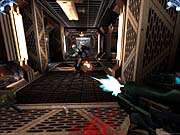
The missions in Unreal II take place in more than 10 unique settings in both indoor and outdoor environments, with a wide variety of mission goals, including search-and-rescue sorties involving downed ships, hostage retrievals, escort patrols, infiltration of (and escape from) enemy bases, and search-and-destroy patrols. Arguably the most intriguing of the missions are those that involve commanding "bot" allies as you defend or assault buildings or locations. In defensive battles you can face several waves of attackers, and to give you a fighting chance these open with a defense configuration screen (similar to the team interface in Unreal Tournament) where you can issue specific orders to each soldier under your command to maximize their firepower. You won't have as much control over teammates when attacking, probably because it's a bit much to coordinate an attack and enjoy the battle at the same time. Verdu says the game compensates for this by making friendly AI players more intelligent when you're doing the attacking.
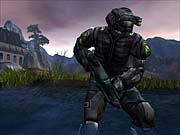
Although we weren't shown all of the game's environments, the ones we did see were quite impressive. In the game's first mission, for instance, you must locate a downed ship on a tropical planet, and as you move toward a rescue beacon you actually see incredibly detailed blades of grass and tress that look like...well, trees, even when you walk right up to them. That might not sound impressive, but when you stop and think of how rarely those objects appear in other first-person shooters--and how crummy they've looked when they are incorporated--you realize how powerful this immersive effect can be. Other missions take place on (and inside) a planet that's actually a living organism, on a volcanic planet replete with moving lava streams, in an underwater base, inside a research lab on a barren planet, and aboard an enemy starship, to name a few.
There are several reasons for the stunning visuals. One is the game's new rendering architecture, which increases polygon counts tenfold for characters and up to a hundredfold for the environments. And support for DXTC (DirectX texture compression), which can reduce texture data to one-eighth its original size, allows Legend to use extremely detailed textures (up to 512x512, compared with Unreal's 128x128 textures) without a drop in frame rate--provided you have a video card with a chipset that supports DXTC (more on that later).
Just as important as the new rendering technology, though, is the use of particle effects for snow, fire, rain, fog, volumetric lighting, sparks, and dust--if it can be affected by some type of force such as gravity or acceleration, chances are Legend probably tried to re-create it with particle effects. After the programmers create the various particle types, a component-based system lets them determine not only which forces will affect the particles, but also precisely how they affect the particles. To demonstrate how realistic visuals created with the system can be, programmer Aaron Leiby fired a rocket near a jet of escaping steam that was bathed in several different colors from overhead lights; the steam that moved in reaction to the passing rocket changed colors accurately to reflect the volumetric lighting. Every weapons effect in the game uses the particle-effects system, so let's have a look at the armory and see just what sort of baddies you'll be firing at.
Weapons, Traditional and Exotic
While some people didn't have a problem with the weapons dished up in the original Unreal, apparently the general consumer feedback revealed that most players were uncomfortable with the fact that the arsenal didn't contain first-person-shooter staples such as a shotgun, machine gun, or rocket launcher. So Unreal II aims to deliver the best of both worlds by offering both "standard" weapons and exotic alien devices, all of which provide dual firing modes and some of which can be armed with different types of ammo. The pistol, shotgun, machine gun, grenade launcher (which can fire five types of grenades, including one that creates a way-cool stasis field), rocket launcher, sniper rifle, and flamethrower (which looks very convincing in action!) are all classified as "Terran standard issue" weapons--that is, any bipedal humanoid can figure out how to use them.
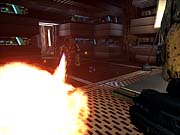
We didn't get to see as many alien weapons, but the ones that were previewed looked like they had lots of potential, particularly for multiplayer games. One was an energy rifle--when fired head-on at a wall its ammo will stay stuck until something passes close by to detonate it and when fired at an angle the ammo will bounce until it finally lodges into place. Another interesting weapon unleashes hunter-killer drones that track down targets unless the drones are destroyed beforehand. Without a doubt, the most devilish device on display was a psionic weapon that drains life from the target, but use it with caution: It backfires and drains your life if you don't maintain line of sight with the target for a few seconds.
Although set in the Unreal universe, the only enemies that return from the first game are the Skaarj. Besides them, you'll square off against Terran Marines, mercenaries hired by megacorporations, the six-limbed Izarians (four arms, two legs, and one bad temper!), the aquatic Shian, and the robotic Drakk. Many enemies are divided into weight classes, which determine their armor and weapons capabilities, and the beefed-up AI ensures realistic behavior by all of them. Enemies decide which weapon to use based on several factors: the value they've been assigned, the distance of the target, and the effectiveness of a weapon in a given situation. They'll also move closer or farther away to reach a weapon's "sweet spot"--they won't unleash a rocket on a target that's nearby--as well as in response to the weapon you're holding. AI enemies rely on a path-node system to determine how to reach their destination, evaluating paths based on all the available information, including speed of movement and a sort of "cost-benefit analysis"--they'll accept damage from a fall, for instance, if they see a big health pack waiting for them near the landing point.
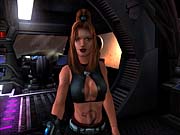
One of the few truly weak points in the original Unreal was Internet play--which is a nice way of saying there wasn't any in the shipping version of the game. By the time it was fully implemented, multiplayer fans had moved on to other games, such as the multiplayer-only Unreal Tournament. Infogrames and Legend both insist that Unreal II's immersive single-player mode will be fully complemented by a great multiplayer game, while simultaneously pointing out that many options for multiplayer were still being debated because so much care had been taken with the single-player game and incorporating the new technologies in the latest builds of the Unreal engine provided by Epic.
Constant Tweaks
Unreal II will feature a total of 20 multiplayer maps inspired by settings from the single-player game, and because those maps were designed to be easily covered on foot, there'll be no vehicles to control in multiplayer games. Naturally, deathmatch and capture-the-flag modes will be featured, but the mode that aroused our interest the most is a new class-based (light, medium, and heavy) team game in which sides battle for control of alien artifacts. Each team's commander controls a replicator used to crank out ammo and weapons based on current energy supplies and the acquisition of artifacts and flags, with ever-increasing levels of firepower becoming available during the course of play. New "tech levels" provide access to several weapon choices, but only the commander can decide what'll be produced to arm the team.
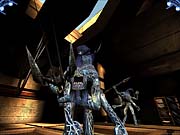
Then again, that might not be how it works at all, because Verdu says this particular aspect of the multiplayer game will be undergoing "heavy tuning" over the coming weeks and months, and the reasons are obvious. For instance, let's say the commander can produce shotguns and assault rifles at a particular tech level, but not both at the same time: Some teammates are bound to scream for whichever isn't being provided. Much play-testing will be needed to guarantee that it's not too easy for one side to gain an insurmountable lead in the early going and that the tech levels are structured in such a way that players will be happy with the choices of weapons and equipment.
One thing that isn't as murky are the system requirements for the game: To see those huge increases in polygon counts and enjoy the brilliant particle effects in their full glory, you'll need a video card with transform and lighting (T&L) capabilities. This doesn't mean that players with popular older cards won't be able to play the game, but they won't enjoy many of the graphical goodies because the game is designed specifically to take advantage of T&L-capable cards to cut down on CPU usage.
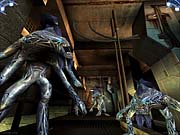
While some might question such a decision, it's certainly not without precedent: Delta Force II, for instance, required a 32-bit AGP video card for Direct3D support at a time when 16-bit Voodoo cards were all the rage, and it didn't seem to suffer too badly in the sales department. And what will the game be asking for as far as CPU horsepower goes? Verdu says this is an "open issue," and the FAQ at the Unreal 2 Web site makes the rather bold claim that the game should "run fine" on a Pentium II 450MHz with a first-generation GeForce card (ATI Radeon cards, which also have T&L capabilities, went noticeably unmentioned). But Verdu also notes that Infogrames and Epic realize Unreal II is aimed at hard-core gamers and that surveys reveal the majority of its potential buyers have or will soon have a T&L-capable video card.
Infogrames is aiming for a second-quarter release of Unreal II. Despite the work being done on the multiplayer modes, the arrival of the final game engine from Epic--coupled with the increased productivity thanks to GOLEM--means there's little reason to think the game won't arrive on time.
Got a news tip or want to contact us directly? Email news@gamespot.com
Join the conversation